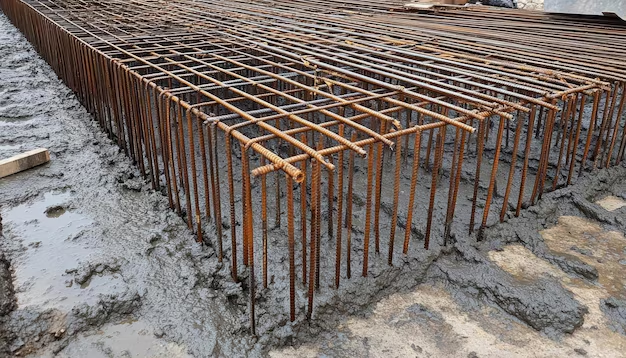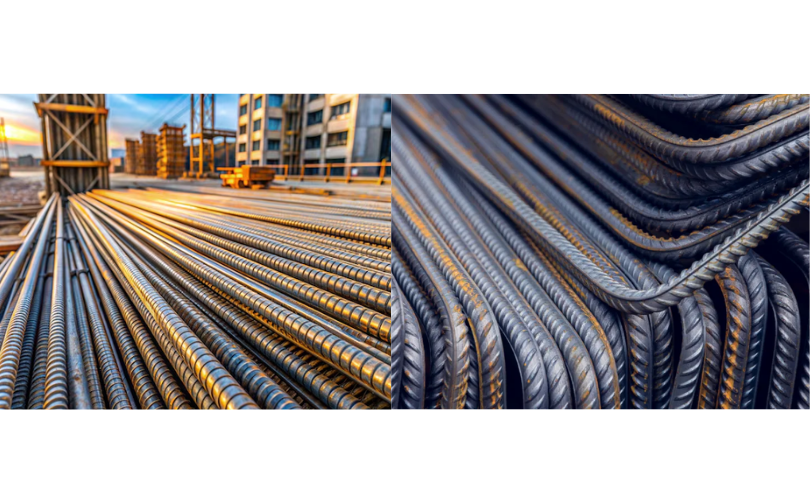It is however important to point out that different varieties of steel have different functions in construction. Bars are used to reinforce concrete and rebars or the reinforcing bars, increase tensile strength by merging into concrete. By the end of this blog, you will be a pro in the differentiation between steel bars and rebars for your building construction.
Steel Bars

A steel bar is carbon-iron alloy in general used in construction work for heavy structures. Common rebar types differ in their chemical makeup in terms of their properties and applications. Iron (Fe) from 96 to 99 % of the total weight of element on the sample. The nature and tensile prop steel depend on the composition of steel and the carbon percentage that ranges from 0.02% to 2.1%.
Applications of Steel Bars
Steels bars are very flexible also. Here are some common uses:
- Construction: Steel bars are very useful in support of foundations and structures within buildings.
- Machine Parts: They are applied to manufacture gears, tools and any other implementing material of the machinery.
- Shipbuilding & Automotive: These industries require substances that will serve them for quite a long time and the substances are all made from these two metals hence their appropriateness.
- Bridges & Railways: Steel bars are very important when it comes to construction because of the load they are able to support.
- Oil & Gas: Applied in drilling rings, pipelines, and transportational systems.
- Defence & Aerospace: Such steel bars are indispensable in manufacturing light and strong materials in such fields.
Rebar

Rebar means reinforcing bar- it is a steel bar for concrete constructions. Reinforcing concrete is adding some material into concrete to strengthen it, the most common material used is steel that’s why it is called steel concrete. Concrete tends to deform under tension and while stretching it loses some strength and rebars bear these tensile forces. This combination forms another material referred to as reinforced concrete.
The rebar can be categorized according to the carbon content but averaged has about 96% to 98% iron. The carbon content typically comprises a minimum of 0.2 % and a maximum of 0.5 %. Other oxide types with much lesser quantities of additions: manganese, sulfur, phosphorus, silicon, vanadium, nickel for certain purposes.
Applications of Rebar
Rebars increase the tensile strength of concrete and are used in various applications, including:
- Structural Integrity: They are used for purposes of the industrial building, floor, roofs and for the residential buildings as well.
- Columns: For every floor, there are loads borne by reinforced concrete columns and high tensile strength.
- Slabs: Rebar slabs play the role of distributing load evenly on the floor so that no cracks are seen on it.
- Tunnels: They need not be protected from ground pressure and survive environmental forces.
- Nuclear Power Plants: They confirm the appropriate safeguarding of nuclear reactions too.
Differences Between Steel Bar and Rebar
| Properties | Steel Bars | Rebars (Reinforced Bars) |
| Definition | Rigid metal rods made of carbon and iron alloys. | Steel bars blended with concrete for tensile strength. |
| Composition | Made of steel or stainless steel. | Made of carbon steel with patterns for bonding. |
| Texture | Smooth or polished, depending on use. | Twisted or patterned to enhance concrete binding. |
| Purpose | Used in manufacturing, construction, and components. | Adds strength to concrete structures. |
| Strength | Varies by grade. | High tensile strength to withstand breaking. |
| Ductility | Varies by composition and application. | High ductility, preventing cracks and tears. |
| Manufacturing Process | Can be cold rolled, drawn, or hot rolled. | Generally hot rolled to create desired shapes. |
| Size and Shape | Available in various sizes and shapes (hexagonal, square, round). | Usually round with diameters ranging from 6 mm to 50 mm. |
| Cost | Pricing varies by size and type; generally expensive. | Generally more cost-effective due to coating materials. |
Conclusion
Steel bars and rebars are vital components in construction, each serving distinct purposes. Steel bars, made from carbon and iron, are essential for various activities, while reinforcement rebars provide tensile strength and minimize cracking when used with concrete. Selecting the right type of steel is crucial to meet project requirements. Walls and Dreams emphasizes the importance of choosing the appropriate materials to ensure the durability and integrity of your construction projects.
FAQs
What are the principal applications of steel?
Application of steel is in the construction of industrial buildings, residential and commercial spaces, and the pipes that are laid underground.
What is a rebar?
Rebar is a bar that is used together with concrete in an endeavor of enhancing tensile strength in the concrete.
Is it possible to use steel bars for Reinforcement bars or commonly known as rebars?
Nonetheless, they are strong, but steel bars do not have any ‘hooking’ mechanism into the concrete like that of rebars that have ribs for better concrete – steel bar cohesion.
How can the rebar strength be determined?
The strength of the rebar is recognized by tensile strength, a vital element in concrete reinforcement.
Which manufacturing techniques are applied for rebars?
Rebars used in this study are made through hot rolling while it is essential that their surfaces have patterns to facilitate bonding with concrete.
How much of an influence does the price of rebars have on the budget of construction projects?
Rebars are relatively cost efficient and indispensable for structural reinforcement, thus providing many years of safer and cheaper construction.
Now, what separates the two rods is what information is given to the bar form.
Bars are therefore larger or thicker than rods while rods are used in other applications and hence their thin sizes.
What are the types of bar reinforcement and what are their typical sizes?
Reinforcing bars available in the market are normal bars, epoxy coated bars and stainless steel bars. The normal size of bars are between 6mm to 50mm.







